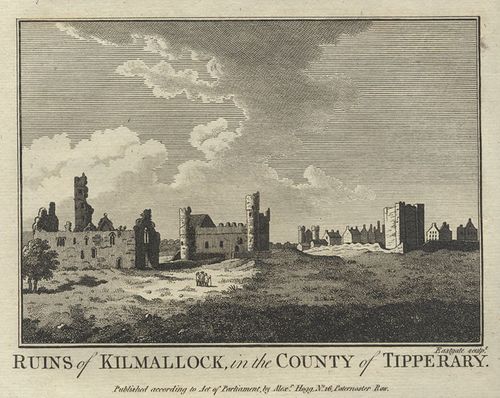Annotation:Ruins of Killmallock (The): Difference between revisions
m (Text replacement - "Century Gothic" to "sans-serif") |
No edit summary |
||
| Line 1: | Line 1: | ||
---------- | |||
{{TuneAnnotation | |||
|f_tune_annotation_title= https://tunearch.org/wiki/Annotation:Ruins_of_Killmallock_(The) > | |||
|f_annotation='''RUINS OF KILLMALLOCK, THE''' (Fotarac Cill-Moceallog). AKA and see "[[Old Walls of Liscaroll (2)]]." Irish, Double Jig (6/8 time). A Major. Standard tuning (fiddle). AABB. Killmallock was once, in the middle ages, the third largest town in Ireland (after Dublin and Kilkenny), and was later the seat of the powerful Earls of Desmond between the 14th and 17th centuries. There are famous ruins of a Dominican Friary at Killmallock, west County Limerick, built in the 13th century but sacked by Cromwell’s forces in 1648. The ruins were an attraction often visited in the 18th and 19th centuries, and parts of the nave, chancel, tower and a window survive today. | |||
---- | |||
---- | |||
'''RUINS OF KILLMALLOCK, THE''' (Fotarac Cill-Moceallog). Irish, Double Jig. A Major. Standard tuning (fiddle). AABB. Killmallock was once, in the middle ages, the third largest town in Ireland (after Dublin and Kilkenny), and was later the seat of the powerful Earls of Desmond between the 14th and 17th centuries. There are famous ruins of a Dominican Friary at Killmallock, west County Limerick, built in the 13th century but sacked by Cromwell’s forces in 1648. The ruins were an attraction often visited in the 18th and 19th centuries, and parts of the nave, chancel, tower and a window survive today. | |||
[[File:Killmallock.jpg|500px|thumb|left|The ruins of Killmallock, 1795]] | [[File:Killmallock.jpg|500px|thumb|left|The ruins of Killmallock, 1795]] | ||
|f_source_for_notated_version= | |||
|f_printed_sources= McGuire & Keegan ('''Irish Tunes by the 100, vol. 1'''), 1975; No. 31, p. 8. O'Neill (Krassen), 1976; p. 57. O'Neill ('''Music of Ireland: 1850 Melodies'''), 1903; No. 1029. O'Neill ('''Dance Music of Ireland: 1001 Gems'''), 1907; No. 242, p. 54. | |||
|f_recorded_sources= | |||
|f_see_also_listing= | |||
}} | |||
------------- | |||
---- | |||
Revision as of 02:42, 15 November 2023
X:1 T:Ruins of Killmallock, The M:6/8 L:1/8 R:Jig S:O’Neill – Dance Music of Ireland: 1001 Gems (242) Z:AK/Fiddler’s Companion K:A A/B/|cBc dcd|ecA AGE|cBd cBA|GEF GAB| cBc dcd|ecA Bcd|cBA BGE|EAA A2:| |:e|aga ece|agf edc|dcd BGB|Acd efg| aga ece|agf edc|Bcd efg|aAA A2:|
RUINS OF KILLMALLOCK, THE (Fotarac Cill-Moceallog). AKA and see "Old Walls of Liscaroll (2)." Irish, Double Jig (6/8 time). A Major. Standard tuning (fiddle). AABB. Killmallock was once, in the middle ages, the third largest town in Ireland (after Dublin and Kilkenny), and was later the seat of the powerful Earls of Desmond between the 14th and 17th centuries. There are famous ruins of a Dominican Friary at Killmallock, west County Limerick, built in the 13th century but sacked by Cromwell’s forces in 1648. The ruins were an attraction often visited in the 18th and 19th centuries, and parts of the nave, chancel, tower and a window survive today.


